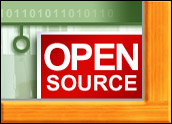
Having recently completed the second issue of Hackett and Bankwell, I have been taking inventory of my accomplishments and lessons learned.
Two years ago, I was working two jobs, writing Web software by day and configuring Linux servers by night. One job was a corporate situation where a lot of the work had been automated, leaving mostly maintenance, and the other was an early-stage Web startup, complete with late night and early morning phone calls, where developing major features overnight had become routine.
Having read countless business and marketing books, worked a few early-stage startup gigs, and even timidly tried a few side projects in the past, by early 2007 I had developed an unbearable itch to thoroughly and successfully find and refine a raw idea.
Although I chose Linux education as the basis for the project for less ideological reasons, I have come to strongly believe that the development of an economic ecosystem around Linux will lead to moving Linux from the server racks and netbooks to ubiquity, complete with more technologically savvy users.
Critical Mass
When I started Hackett and Bankwell, my goal was to try and reach more people with open source software because I personally believe proprietary software is antithetical to curiosity, thus responsible for any number of ills of society. After years of hearing variations of statements like “If more people used Linux, more hardware or video game or specialty software manufacturers would bother or be pressured to accommodate Linux users,” I began to agree.
Yeah, Linux on the desktop has some issues, but the serious demand for Linux sysadmins creates demand for those skills. Surely, I thought, creating an educational comic to teach key concepts could benefit newcomers, and this particular project would have the added benefit of possibly reducing the time it takes to explain various key Linux concepts (What is a Gnome? How about GNU? Bash?), freeing up more time for hacking.
Upon entering the marketplace, I noticed how few Linux-related businesses exist. Sure, there are hardware manufacturers, hosting companies, some software companies, and a few non-profit organizations related to recycling or charitable giving, but there is a general absence of peripheral cottage industries around Linux. In effect, the majority of Linux-related jobs are related to Linux administration or software development, which is not as optimal as it sounds. Consider logo and design graphics from commercial software versus open source.
While the commercial software visual elements are almost always better, it’s not because the proprietary graphics software is better than the open source version. The difference is that the commercial software manufacturer more than likely has people whose sole job is to design graphics, and it’s entirely possible that person is both talented and skilled at it. But really, the difference is even bigger than just having graphics staff.
By having people design graphics using special software, that software manufacturer is helping another proprietary software manufacturer to lock customers into its graphics software. Competing against the private software establishment is essential to creating new career and investment opportunities in the future.
The Business of Free Software
So, what’s the best way to get entrepreneurs to build businesses around Linux? In everything I’ve ever read about businesses using Linux, the profit-generating opportunities have seemed sparse: subscriptions, donations or support.
Part of the reason I started an educational resource was because education looked like the low-hanging fruit — everyone needs it, especially if moving the baseline is the goal. But to build a fertile environment for Linux/FOSS-oriented businesses, one must look beyond the technology itself and involve people who are looking for new ways of doing business and engaging one another.
To use the graphics example again, every high-end designer was once a newbie with a blank slate, looking to learn; the same is true for the CPA, the attorney, and the sound engineer. The various newcomers and prospects are each looking for something to benefit themselves, and each type of user represents numerous opportunities for attracting more resources and attention to Linux/FOSS.
Unlike commercial software firms that produce software based on feasibility and focus groups, people involved in free and open source software have the ability to engage customers in a way that aligns their goals with the goals of the software developers — an alignment that doesn’t receive nearly the credit it deserves.
Rather than worrying about how to extract financial rewards from Linux’s value now, I am more concerned about getting Linux-based systems deployed where practical and to work to get the ideas and skills associated with FOSS into the heads of young people, so they will have a broad platform of abilities from which to launch their careers in the future.
The traditional hurdles faced by technology companies have changed and will continue to change as the populace grows more dependent on and hopefully more savvy about technology. Serendipitously, a key way to help young people grow up to be more tech savvy is to get them involved early and often in open source software, where they can experience the organic nature of the project.
Making FOSS part of the educational and business landscape helps create more interest while simultaneously increasing average levels of skill and understanding.
Computer software is only about two human generations old, free software less than one, and Linux itself is only just becoming an adult. Still, individuals and organizations who benefit from locking down software want us to believe that we should pack up and go home because we haven’t been able to produce a revenue model lucrative enough to entice venture capital to commit funds to developing more advanced open source software — a positively ridiculous idea.
Proprietary software isn’t fundamentally “wrong;” freedom is just more optimal. Free and open source software is a manifestation of the frontier, and although open source software has been spectacular at opening new opportunities for software upstarts, particularly software as a service, we are only at the dawn of this new era that will be marked with new business models and a much broader definition of commodity software.
For now, companies like 37signals have found a sweet spot, but they don’t offer anything that can’t be currently or eventually accomplished with GPL software.
It’s fantastic that small businesses are able to make money in exchange for granting access to software, but that underlying strategy is not entirely dissimilar from a traditional software company. Whereas the olden days of proprietary software involved installing compiled code on your local machine, a common new model for commercial software is to use an open source stack with a subscription on top.
Although basically any commercially available software could be replaced with a free alternative, many commercial solutions remain dominant. Sometimes the commercial software had better branding and design, as perhaps in the case of 37signals, and sometimes the commercial version has a key advantage such as a better user interface because it was written by a tightly-knit team that was recruited and paid to focus.
Historically, this has been the point at which I would argue, “If you want a fancy UI, just get the the proprietary version,” but as software grows in complexity, scope, and importance, the baseline of what constitutes an acceptable user experience rises, too.
Opportunity Knocks
It’s particularly apparent during this time of deflation and recession that the opportunities for Linux and FOSS infrastructure development are plentiful. Converting people to Linux/FOSS is worthwhile and having more businesses and organizations using them will benefit users within and beyond the open source communities.
It’s generally more lucrative to lock people out and charge them for admission, but with software technology, we have reached the other side, where smaller software projects develop micro-targeted solutions and the concept of an average home computer user is replaced by a mosaic of usage attributes.
Reasonable minds can disagree on specificities about the future, but it’s clear that the open source software frontier is wide open right now, waiting to be shaped by what we want to bring to it.If you would like to read more about the specific lessons I’ve learned producing a Linux-oriented product so that you can avoid them, please visit my blog, where I have begun to document my experiences.
Jeremiah T. Gray is a LinuxInsider columnist, software developer, sysadmin and technology entrepreneur. He is a director of Intarcorp, publisher of the Linux-oriented educational comic book series, “Hackett and Bankwell.”
















































